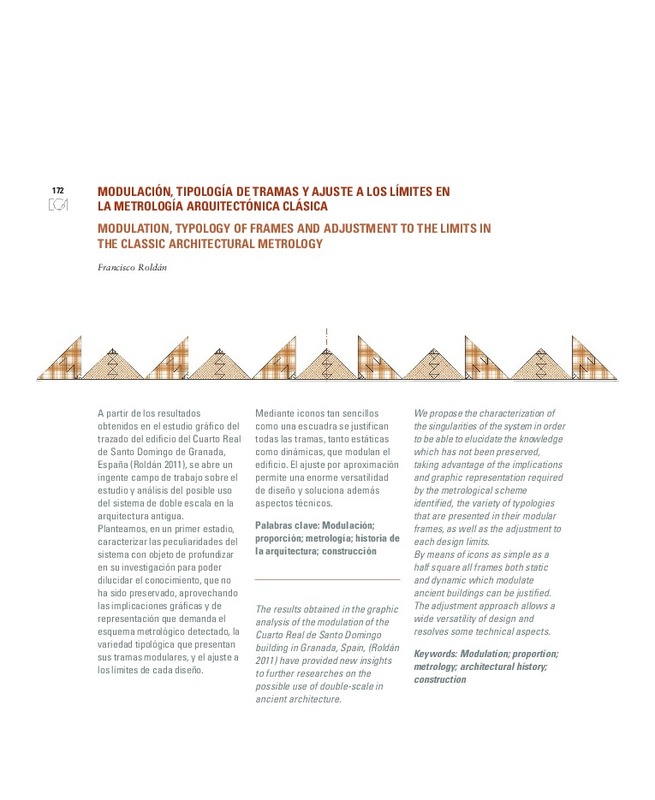JavaScript is disabled for your browser. Some features of this site may not work without it.
Buscar en RiuNet
Listar
Mi cuenta
Estadísticas
Ayuda RiuNet
Admin. UPV
MODULACIÓN, TIPOLOGÍA DE TRAMAS Y AJUSTE A LOS LÍMITES EN LA METROLOGÍA ARQUITECTÓNICA CLÁSICA
Mostrar el registro sencillo del ítem
Ficheros en el ítem
| dc.contributor.author | Roldán, Francisco
|
es_ES |
| dc.date.accessioned | 2013-03-01T10:32:24Z | |
| dc.date.available | 2013-10-23T22:30:53Z | |
| dc.date.issued | 2012 | |
| dc.identifier.issn | 1133-6137 | |
| dc.identifier.uri | http://hdl.handle.net/10251/27423 | |
| dc.description.abstract | [EN] The results obtained in the graphic analysis of the modulation of the Cuarto Real de Santo Domingo building in Granada, Spain, (Roldán 2011) have provided new insights to further researches on the possible use of double-scale in ancient architecture.We propose the characterization of the singularities of the system in order to be able to elucidate the knowledge which has not been preserved, taking advantage of the implications and graphic representation required by the metrological scheme identified, the variety of typologies that are presented in their modular frames, as well as the adjustment to each design limits. By means of icons as simple as a half square all frames both static and dynamic which modulate ancient buildings can be justified. The adjustment approach allows a wide versatility of design and resolves some technical aspects. | es_ES |
| dc.description.abstract | [ES] A partir de los resultados obtenidos en el estudio gráfico del trazado del edificio del Cuarto Real de Santo Domingo de Granada, España (Roldán 2011), se abre un ingente campo de trabajo sobre el estudio y análisis del posible uso del sistema de doble escala en la arquitectura antigua. Planteamos, en un primer estadio, caracterizar las peculiaridades del sistema con objeto de profundizar en su investigación para poder dilucidar el conocimiento, que no ha sido preservado, aprovechando las implicaciones gráficas y de representación que demanda el esquema metrológico detectado, la variedad tipológica que presentan sus tramas modulares, y el ajuste a los límites de cada diseño. Mediante iconos tan sencillos como una escuadra se justifican todas las tramas, tanto estáticas como dinámicas, que modulan el edificio. El ajuste por aproximación permite una enorme versatilidad de diseño y soluciona además aspectos técnicos. | es_ES |
| dc.language | Español | es_ES |
| dc.language | Inglés | |
| dc.publisher | Editorial Universitat Politècnica de València | es_ES |
| dc.relation.ispartof | EGA. Revista de Expresión Gráfica Arquitectónica | |
| dc.rights | Reserva de todos los derechos | es_ES |
| dc.subject | Modulación | es_ES |
| dc.subject | Proporción | es_ES |
| dc.subject | Metrología | es_ES |
| dc.subject | Historia de la arquitectura | es_ES |
| dc.subject | Construcción | es_ES |
| dc.subject | Modulation | es_ES |
| dc.subject | Proportion | es_ES |
| dc.subject | Metrology | es_ES |
| dc.subject | Architectural history | es_ES |
| dc.subject | Construction | es_ES |
| dc.title | MODULACIÓN, TIPOLOGÍA DE TRAMAS Y AJUSTE A LOS LÍMITES EN LA METROLOGÍA ARQUITECTÓNICA CLÁSICA | es_ES |
| dc.title.alternative | MODULATION, TYPOLOGY OF FRAMES AND ADJUSTMENT TO THE LIMITS IN THE CLASSIC ARCHITECTURAL METROLOGY | es_ES |
| dc.type | Artículo | es_ES |
| dc.date.updated | 2013-02-15T13:01:47Z | |
| dc.identifier.doi | 10.4995/ega.2012.1448 | |
| dc.rights.accessRights | Abierto | es_ES |
| dc.description.bibliographicCitation | Roldán, F. (2012). MODULACIÓN, TIPOLOGÍA DE TRAMAS Y AJUSTE A LOS LÍMITES EN LA METROLOGÍA ARQUITECTÓNICA CLÁSICA. EGA. Revista de Expresión Gráfica Arquitectónica. 17(20):172-183. https://doi.org/10.4995/ega.2012.1448 | es_ES |
| dc.description.accrualMethod | SWORD | es_ES |
| dc.relation.publisherversion | https://doi.org/10.4995/ega.2012.1448 | es_ES |
| dc.description.upvformatpinicio | 172 | |
| dc.description.upvformatpfin | 183 | |
| dc.description.volume | 17 | |
| dc.description.issue | 20 | |
| dc.identifier.eissn | 2254-6103 |








